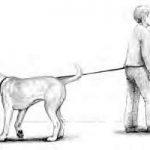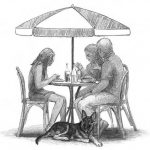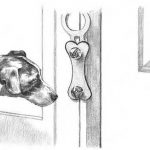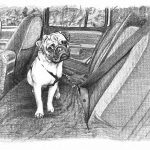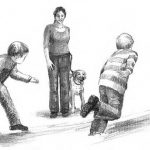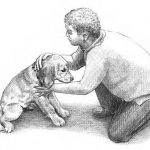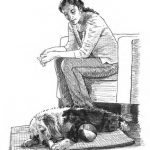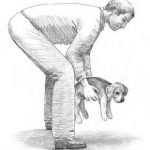Getting Everyone Involved
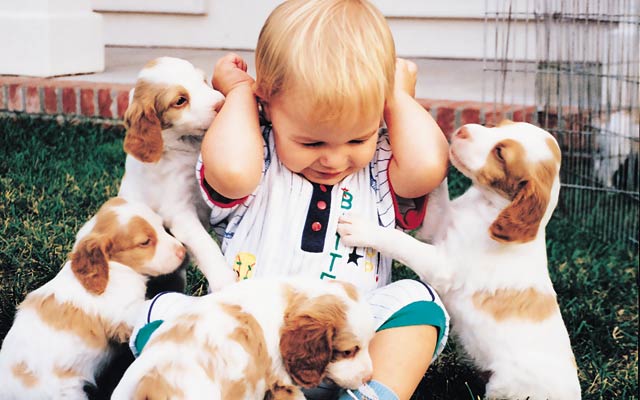
In This Chapter
- Encouraging consistency among your family and friends
- Creating a clan of helpers
- Comparing puppy schools and private trainers
Bringing up a well-rounded puppy in today’s society is definitely not a one-person job, even if you do live alone. However, if you’re surrounded by family members or friends, striking a balance between consistency and cooperation takes some effort. You soon find out that sometimes your puppy is easier to train than your roommate. Finding outside help — from a veterinarian and dog walker to a fun, informative puppy teacher — is paramount too.
A Team Effort: Getting Help and
– Set your boundaries early on.
– Show effectiveness through example.
– Communicate your methods positively (positive-reinforcement training isn’t just for puppies anymore!).
Making sure your family and friends are consistent with your pup
Warning!
Mixed messages often create maniac rituals — especially when new people arrive. Instead of having one clear thought or a solid understanding of how to respond, the puppy must now dance around trying to determine what this new person’s rules are.
Table 10-1 | Consistency Chart | ||
Behavior | Routine | How to Extinguish Bad Behavior | Directions Given |
Greeting | Pup must sit, roll over, or get toy | Fold your arms over your face or tug on pup’s drag leash | “Sit,” “Belly up,” or “Get your toy” |
Barking for attention | Find another way to get attention | Ignore your pup’s behavior completely | “Get your toy” when barking stops |
Nipping | Pup must lick or prompt a need | Slip your finger under your pup’s collar or take leash and tug away | “Kisses,” “Out,” or “Go to your mat” |
Engaging in some interior decorating
Tip
After you’ve cleared the floors, have your family help you organize a play station in each room (see Chapter Home Sweet Home for info on creating play stations). Place all your puppy’s toys and bones at the play station. Your puppy quickly bonds to this area if it’s a center point of attention and treats.
Creating a cause-and-effect chart
Tip
To help your family see the effects of their interactions with the puppy, create a cause-and-effect chart. Just the slightest modification in behavior can help your puppy understand and can keep your family motivated in the training process. Table 10-2 shows an example.
Table 10-2 | Cause-and-Effect Chart | |
Behavior | Encouraging Reaction | Discouraging Reaction |
Jumping in greeting | Push, shout, or interact | Ignore, look away, or fold arms over face |
Nipping in play | Physically correct or jerk hand away | Leave a leash on your puppy and pull him off; determine if a need is pressing; play a game or isolate for a nap |
Stealing an object | Yell, chase, and capture | Walk out of the house, or shake a treat cup while pretending to eat the treats yourself as you walk away |
Barking at the door | Yell or physically correct | Leave a leash dragging to interfere casually — redirect pup to your side; use a treatoriented lesson to refocus |
Piddling when excited | Yell or stick his nose in it | Ignore your puppy until he has calmed down; externalize his focus with a toy or treat cup |
Remember
Naughty behaviors can become habit through well-meaning, but nonetheless interactive, attention.
It Takes a Village: Enlisting Outside Help
Your veterinarian
Warning!
Puppies can be very impulsive — they often swallow things that look edible before even considering whether they actually are. So, at your first veterinary visit, ask the doctor if she has a recommended method for inducing vomiting. You should also find out the poison-control hot-line number and always keep it by your phone in case of an emergency. As well, seek out a 24-hour emergency veterinary hospital in your area. Keep the hospital’s number by your phone also. Accidents can happen during off hours, so have a plan.
Dog walkers
Remember
Whether your life demands consistent hours away from the home or circumstance steps in to temporarily rearrange your schedule, knowing a dog walker can make the difference between a happy puppy and a stressed out one. Puppies are like human babies in that they have a strong need dependency. Even though an adult dog can hold it until you get home or can survive until a late meal, your puppy may very well eat your walls if you get stuck in traffic. A reliable dog walker can be a real godsend in times like these.
Groomers
Tip
When deciding on a groomer, visit each facility ahead of time, and ask to see where the dogs are stationed while they’re waiting their turn or drying. What vibes do you get from each place? Do the dogs already there seem happy or stressed? Is it clean and almost odor free? Would you want to get a haircut here if you were a dog?
Remember
Watch the groomer’s handling techniques. Groomers need to be rougher than you would be, but cursing or harsh corrective techniques are unnecessary. Ask the manager what the pay structure is and find out their recommended drop-off and pick-up schedule. Also inquire about what they do when a dog needs to, or does, eliminate in the holding area. Don’t accept anything less than “We remove the dog and clean immediately.”
Doggie day care
– How are the dogs/puppies grouped?
– What do they do in case of a dog fight?
– Who is the veterinarian on staff? If they’re off location, where is the doctor located?
– Do they kennel overnight?
– What plans are in place if you’re delayed?
– Do they offer auxiliary services, such as grooming, training, medical care, or medicating?
Warning!
Puppies, like kids, pick up both good and bad habits from their friends. If you notice your puppy roughhousing or being uncharacteristically defiant, ask to meet the dogs he plays with. If his playmates are rubbing off bad energy, you may consider asking whether your puppy can be placed in another group. Or, consider taking a break from day care until your puppy is more mature because an older puppy or dog is less likely to acquire bad habits.
Puppy kindergarten
Remember
Puppies are impulsive and excitable. Find a class whose teacher takes excitability in stride and doesn’t single out any one puppy as problematic. Your puppy is who he is: The goal of puppy school is to discover your puppy’s personality and how to modify your approach of communicating with him.










